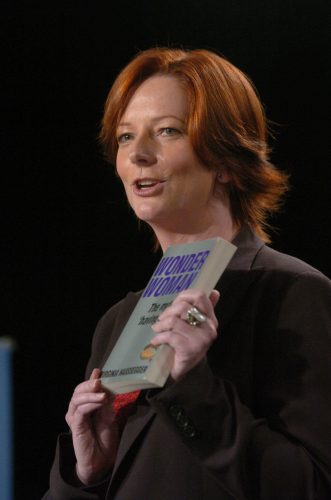You know the fashionistas of the world have won the war when Germaine Greer steps in. Not to fight ’em on the front line, or smack ’em in the giblets as some would like to do to Greer right now, but to join them.
Ever cranky and spewing inkwells of indignation, Greer has set her sights on frocks, and turned her hand to fashion writing. And it isn’t pretty.
In this week’s Guardian newspaper, Greer is the full bottle on Michelle Obama’s fashion sense.
In describing Obama’s victory night dress, at that breathtaking moment in history when she strode on to the stage at Grant Park in Chicago, Greer deploys the sharpest prongs of her forked tongue. The dress’s striking black and red motif is a ”chaos” of violent colour, she says, with an ”eye-burning red panel that splattered itself down the front like a geometrical haemorrhage”.
Greer conjures up spiteful images of deadly coral snakes and venomous spiders, to suggest the blood-red splattering is somehow a warning about this woman’s ”destructive potential”. We turn to wondering where Obama hides her fangs and horns.
It’s gutsy stuff by Greer. In fact, not even the most mealy-mouthed and steely-eyed, whippet-thin, fashion editor from Vogue or Vanity Fair could sting quite like this.
As for Greer’s account of the outfits worn by Obama’s daughters, well, you can only wonder what the liberation lady must have been slurping when she wrote the piece. Greer’s complaint about the black dress worn by seven-year-old Sasha, and the red one worn by 10-year-old Malia, is that they weren’t feminine enough. She admits that any colour is better than pink. But for the once- grand dame of tight jeans and tits, these ”robust” frocks offend because they ”hardly strike one as girly”.
Then the war gets really grisly. Greer ends her fashion column with some sycophantic pap about Obama’s dress designer; who must be upset that his original design has been so wrecked by the big, black woman, with the ”bigger head”. Then Greer comes back to the red on black motif – and just in case the reader hasn’t smelt blood, she twists the knife: Obama’s dress is likened to a ”butcher’s apron.”
Her slaughtering done, Greer then signs off. Right then, in a gobsmacking moment, the reader is reminded of Greer’s exquisite and blistering brilliance.
But not so brilliant was this week’s announcement by Australia’s Minister for Youth, Kate Ellis. Rather than attack them at their own game, Ellis is attempting to join forces with the fashionistas – the designers, fashion magazine editors, celebrity models, and fashion advertisers.
The young minister – who wears the yoke of being voted Australia’s sexiest MP – wants to gather a national advisory group of body- image watchdogs. Their job will be to police a voluntary code of conduct for the fashion and advertising industry.
All the rhetoric reads nicely. But the reality stinks. Of course we’d all love to see magazines agree to identify which photo images have been digitally altered, or enhanced. And, yes, it would be nice to see a diverse range of body shapes among models on the catwalk and in photo shoots. And it would be even better to know that magazines and television shows would avoid the glamorisation of skinny models and celebrities. But in truth, none of this will happen.
Mia Freedman, a former editor of Cleo, Cosmopolitan and Dolly, argues that no fashion magazines will abide by this kind of voluntary code, because they’re into selling fantasy, not reality. And she’s right.
Magazines that celebrate fashion and celebrity culture simply fly off the shelves in Australia. The more pictures, the more we buy them. We’re a nation of junk celebrity addicts, fixated on fashioning our lives around the ”It girl” and the ”In thing”. You only need to peek at the endless drone of reality TV shows to see how deeply the fashionista and celebrity culture has penetrated.
The last thing the fashion-junk hungry are going to do is buy reality.
In truth, our lives are messy: Australians are fat, our hair is limp, our skin dry, our homes grotty, our jobs boring, and our partnerships, perhaps, dull and uninspiring. It’s human nature to wish for something better. And we do. Gorging ourselves on a diet of make-believe beauty and reshaped reality seems to be the modern-day antidote to our crushing disappointments.
And what is real any more anyway?
Those celebrity goddesses we love and hate seem to be merging into one. Mostly, they all look the same – noses, eyelids, cheekbones are increasingly sculptured by the same knife, or sophisticated software.
As one frustrated editor huffed, in response to the minister’s voluntary body image code, magazines would be kept so busy tagging altered images, there would be no time to print. Every fashion magazine image is altered, and every photo used to sell a product is enhanced.
And now that digital photography has made us all masters of our own image, we do it too. Facebook albums and MySpace websites attest to that. Even our most intimate life moments are remembered with the help of digital touch-ups.
Scrolling through a friend’s wedding photos recently, I noticed how the sky was bluer, the grass greener, the dress whiter, and the bride thinner than I recalled. Indeed, the ceremony had been edited into a Luhrmann-like box-office romance.
But that’s the thing. Reality is so easily manipulated. And we are so willingly fooled.
Yet, no one plays at fooling us quite as well as the grumpy Greer.





